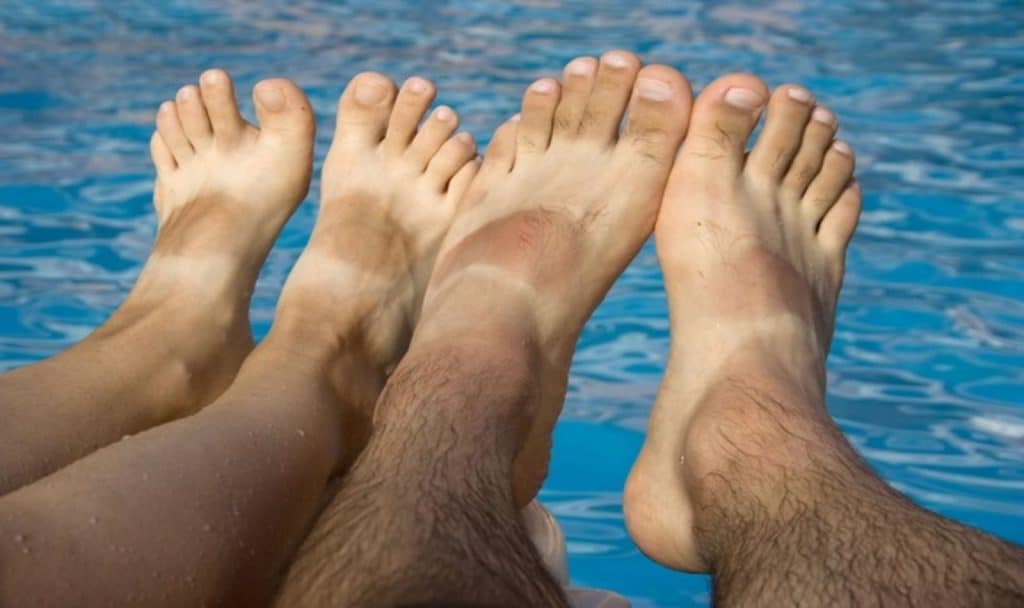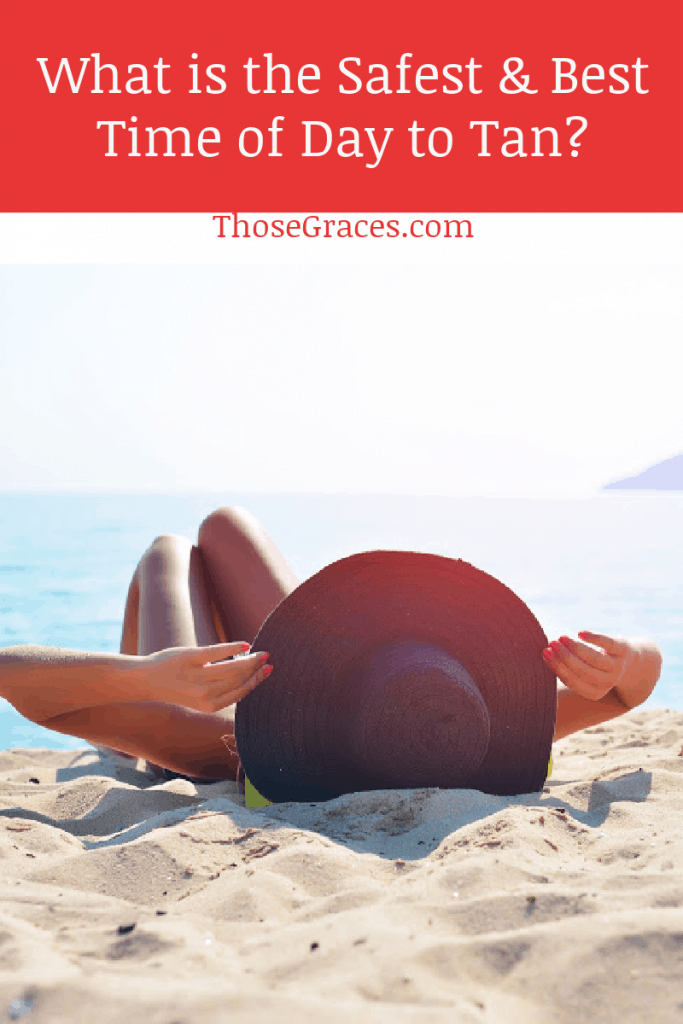What is the best time to tan safely and effectively?
The answer is different for both halves of that question, actually.
Read on to learn when- if ever- it’s safe to tan outside as well as the most effective time for achieving that golden shade you’re after.
Table of Contents
THE BEST TIME OF DAY TO TAN SAFELY is “NEVER”
As I mentioned above, this question has two very distinct answers, and you’re not going to like the first one.
The best time of day to tan SAFELY is never. Sorry, but there is NO SAFE time, period. Not morning. Not noon. Not night. Heck, not even in a tanning booth!
There is only one safe way to tan, and that’s through a bottle (in other words, by using self-tanning lotions and home spray tan machines).
However, since you’re here looking for the best time to get a tan outside, I’m going to assume that you understand the risks & that you’re a grownup who can make your own decisions.
I’m not here to judge. That said, the following is strictly for informational purposes only. We in no way endorse or recommend tanning outdoors.
Check: Can You Sweat After a Spray Tan?
What is the Best Time to Get a Tan Outside Effectively?
So, you’re ready to start your tanning process, but what is the best time for you to expose your skin to the sun?
I mean, you don’t want to end up with sunburns; the goal is that bronze glow.
Before we can figure out the best time to tan, we should understand exactly how tanning takes place.
Don’t worry, we won’t get too deep into the science. No one has time for that, right?
So, you know that the whole tanning process is triggered either by natural sunlight or by artificial UV radiation (like in tanning beds).
Well, that radiation is delivered in frequencies of UVA, UVB, or a combination of both, and in different intensities. The UV Index is commonly used to measure the intensity.
While you can more or less control the intensity when you’re using artificial light, obviously you can’t control the sun. So you want to choose a time when the intensity is at its lowest.
The best time to tan outside is in the morning, before 10am or in the evening after 5PM .
The sun rays are strongest between 10am and 4pm, so tanning between these hours will do you more harm than good. Your skin will burn and suffer damage.
As a result, it’s best to be smart and tan when the sun is less intense.
READ MORE: Can You Get a Tan in the Winter?
Why Tan After 5 pm?
If you’re a busy mom or you’re simply busy around the clock, the only time you may be able to carve out a few moments to tan is after 5 pm.
While it may not give you that golden glow you’re after as quickly as morning tanning will, you can still make it work.
Laying out after 5 pm may also be a good strategy for those who are just trying out tanning for the first time.
And even if you’re like me and you’re always out & about in the sun, after a long winter season, it’s just smarter to introduce your body to tanning gradually.
This will help you achieve healthy and glowing skin, compared to if you went full-blown on day one.
Also, the UV-index is low after 5 pm, so the chances of getting a sunburn are very slim, so it’s a bit safer.
Note, however, that safer doesn’t necessarily equal safe.
Check: Does Coconut Oil Make You Tan Faster?
How Warm Should It Be to Tan?
The short answer is, it doesn’t have to be very warm to get a perfect tan. In fact, if it’s too warm, it’s probably not the best time to get a tan.
And yes, this applies to those who have dark skin too. The sun is too powerful when it’s at its peak, and you can suffer DNA damage.
I have slightly dark skin, and I’ve realized I get sunburns after a few minutes of exposure to hot sun rays.
This is especially on my thighs and legs, which means not rocking short skirts, so it’s pretty annoying.
Luckily, you don’t need the earth to be very warm to get a great tan. This can be best explained by the fact that it’s possible to tan or get a sunburn on a cloudy day.
Even though the clouds are obscuring the sky, UV rays can still pass depending on the cloud’s thickness.
Thin clouds block tiny UV rays, and due to the scattering of light, they can enhance the UV levels.
Unfortunately, many people underestimate the sun’s power when it’s not very hot and end up damaging their skin or getting significant burns.
In fact, many people get sunburns when it’s cloudy than on sunny days because they think it’s not warm enough for sunscreen.

Uncover the secrets of tanning on cloudy days. Check out our article ‘Do you tan better with clouds‘ for all the answers.
ALSO CHECK: Best Tan Through Swimwear
Do You Tan Faster When It’s Hotter?
The short answer is no, you don’t tan faster when it’s hotter. Air temperature plays absolutely no role in how the sun’s rays alter your skin.
I’ve come across quite a few people who believe that tanning only occurs due to high temperatures outside.
And it makes sense, right? I mean, what tans your skin is sunlight, and intense sunlight also warms up the earth’s surface.
So, the hotter, the better, right? Absolutely not. The only heat that’s important for you to tan is the “heat” from the sun.
Tanning under very hot temperatures is very dangerous and can potentially lead to cancerous cells.
By the way, you can also get a tan or burn smack-dab in the middle of winter. So, make sure you use sunscreen even if it’s ten below outside.

Related: Does Baby Oil Help You Tan?
Tanning in the Morning vs. Afternoon
Although you can get a good tan both in the morning and in the afternoon, tanning in the morning is better.
This is especially crucial for individuals with fair, light, and sensitive skin.
Scheduling your tanning in the morning when the sun rays are relatively low and the body is ready to fix DNA damage will allow you to tan safely.
This is backed up by research conducted by Science Daily showing that when mice are exposed to UV rays in the morning, their risk of getting cancer increases.
Wait, what? Isn’t that a bad thing? Well, for the mice, yes.
However, researchers explained that mice and humans have “circadian clocks” that “run counter to each other.” They wrote,
This key difference in biology means that humans are most protected from the sun’s harmful rays when mice are most susceptible, and vice versa.
Check: How Long in the Sun to Get Vitamin D?
What is the Best Time of the Day to Tan (Final Words)
Again, there is no safe time of day to lay out in the sun to tan, period. However, if you’re going to do it anyway, opt for mornings before 10 or evenings after 5.
As much as it may be sooooo tempting to just lay in the sun during afternoons when the sun is very hot, and get a “quick tan”, it will only lead to uneven tans, burns, and skin damage.
I know you want that bronze glow fast, but it’s safest to schedule your tanning when the sun is mild.
It may take longer, but it will build-up, and the results will be mind-blowing.
Enough about me now. What are your best tanning hours?




